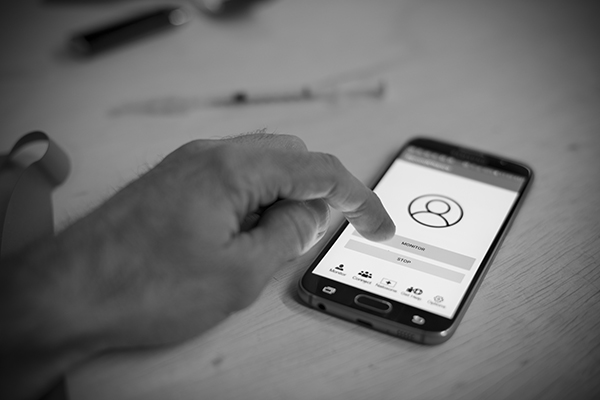
Someone in the United States dies from an opioid overdose every 12 and a half minutes, according to data from the National Institute on Drug Abuse, and the rise in fatalities stemming from illicit opioid use is widely recognized as a public health epidemic. Many of these deaths could be prevented by rapid detection and intervention, including the administration of naloxone to reverse the effects of an overdose. Now, thanks to researchers in the Allen School’s Networks & Mobile Systems Lab and UW Medicine’s Department of Anesthesiology & Pain Medicine, a solution for preventing opioid-related deaths may be at hand. In a paper published today in Science Translational Medicine, the team describes a new contactless smartphone app capable of detecting signs of opioid overdose. Called Second Chance, the app converts the phone’s speaker and microphone into an active sonar system to unobtrusively monitor a person’s breathing and movements from distances of up to three feet, looking for patterns that indicate that they may be in danger.
According to one of those researchers, Allen School professor Shyam Gollakota, the ultimate goal in developing the app is not only to monitor a person’s condition, but eventually be able to connect users immediately with potentially life-saving treatment. “The idea is that people can use the app during opioid use so that if they overdose, the phone can potentially connect them to a friend or emergency services to provide naloxone,” Gollakota explained in a UW News release.
But first, the team had to develop a reliable algorithm that would work in real-world settings. Gollakota and his collaborators — Allen School Ph.D. student Rajalakshmi Nandakumar and Dr. Jacob Sunshine, a physician scientist at UW Medicine — looked northward to Insite, the first legal supervised injection site in North America. Located in Vancouver, British Columbia, Insite hosts approximately 500 supervised injections per day. There, Nandakumar and her colleagues were able to gather data on individuals’ breathing patterns before and after opioid injection in a safe setting — gaining valuable insights into how Second Chance might function in actual situations where opioids are being used.
“The participants prepares their drugs like they normally would, but then we monitored them for a minute pre-injection so the algorithm could get a baseline value for their breathing rate,” Nandakumar explained. “After we got a baseline, we continued monitoring during the injection and then for five minutes afterward, because that’s the window when overdose symptoms occur.”
Those symptoms might include cessation of breathing for 10 seconds or more — known as post-injection central apnea — and opioid induced respiratory depression, in which a person’s respiratory rate slows significantly to seven or fewer breaths per minute. In addition to measuring a person’s breathing, the app is capable of detecting changes in a person’s posture, such as a slumping of the head, which could indicate that they are in danger. In cases where someone is alone with no one to witness symptoms such as these, an app like Second Chance could be their only means of getting help. For this reason, the researchers couldn’t leave the effectiveness of their algorithm to chance; they had to be confident that the app would do what it was designed to in the wild. To that end, they looked for a way to test the app on symptoms consistent with an overdose without putting anyone at risk.
Overdose events at facilities like Insite are rare by design. But Sunshine, an anesthesiologist, knew of another type of facility where many of the same symptoms can be safely simulated: the operating room. “When patients undergo anesthesia, they experience much of the same physiology that people experience when they’re having an overdose,” he explained. “Nothing happens when people experience this event in the operating room because they’re receiving oxygen and they are under the care of an anesthesiology team.”

The team worked with Sunshine’s colleagues in UW Medicine to test the algorithm in what amounted to a real-world simulation of an overdose, with the help of healthy patients undergoing elective surgery who offered their informed consent. During their regularly scheduled procedures, the participants were administered standard anesthetic medications that prompted 30 seconds of slowing or stopped breathing while being monitored by Second Chance. In 19 out of 20 cases, the app correctly detected the symptoms that correlate to an overdose; in the one example that it didn’t, the breathing rate was just above the threshold of what would be considered a sign of overdose.
Having validated their approach, the researchers aim to commercialize Second Chance through Sound Life Sciences, Inc., a digital therapeutics company spun out of the University of Washington, and seek approval from the U.S. Food and Drug Administration (FDA). While the app is technically capable of measuring symptoms consistent with an overdose of any form of opioid, including prescription opioids taken by mouth, the researchers are quick to point out that so far, they have only tested it in scenarios involving use of illicit injectable opioids — the most common source of death by overdose. As Sunshine points out, it’s a human toll that is completely preventable with timely intervention, which as the name of the app suggests, would offer people the proverbial second chance.
“The goal of this project is to try to connect people who are often experiencing overdoses alone to known therapies that can save their lives,” he said. “We hope that by keeping people safer, they can eventually access long-term treatment.”
Learn more about Second Chance in the Science Translational Medicine paper here, the UW News release here, and a related UW Medicine story here. Check out coverage by Scientific American, MIT Technology Review, Science News, CNBC, Mother Jones, U.S. News & World Report, Axios, Futurism, CNET, Fast Company, Engadget, New Atlas, The Verge, Smithsonian, KOMO News, UPI, Tech Times, TechSpot, the Associated Press, and MD Magazine. Listen to Nandakumar discussing the Second Chance app on NPR’s Science Friday here, and watch a related Reuters video here.

